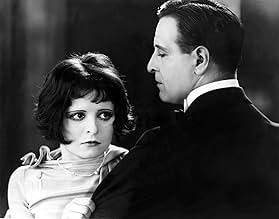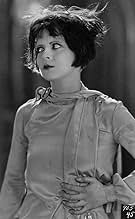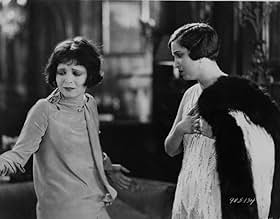A young girl becomes a "flapper", defying her parents and the community.A young girl becomes a "flapper", defying her parents and the community.A young girl becomes a "flapper", defying her parents and the community.
- Director
- Writers
- Stars
- Awards
- 2 wins total
- Director
- Writers
- All cast & crew
- Production, box office & more at IMDbPro
Featured reviews
DANCING MOTHERS (Paramount, 1926), directed by Herbert Brenon could very well be a backstage musical about young wives choosing theatrical careers in the chorus line over being stay-at-home moms. In spite of a promising idea for such a title, DANCING MOTHERS is actually a drama featuring society types, notably women in fur coats, expensive dresses, smoking with cigarette holders and riding in a rolls Royce. Taken from the play by Edgar Selwyn and Edmund Goulding, it depicts upon one particular mother, taken for granted by her family, who chooses to break away from her lonely existence by stepping out to enjoy life, much to the dismay of her cheating husband and selfish/ carefree daughter.
The story begins on an ocean liner, "Homeward bound for America - the first day out" where debonair playboy Jerry Naughton (Conway Tearle), traveling along with his companion, Irma Raymond (Elsie Lawson), meets Catherine "Kittens" Westcourt (Clara Bow), a youthful flapper, and her wealthy father, Hugh (Norman Trevor), on deck. On "their last day out," Kittens and Jerry have become inseparable while her father and Irma have become romantically involved. As the ship docks New York, Mrs. Westcourt (Alice Joyce), the once famous Ethel Wright who "On December 13, 1907, abandoned her stage career to marry the wealthy banker," awaits their arrival, but their union as a family is short lived. "And so it went on ... for a fortnight the Westcourt country home had seen little of Ethel's husband and daughter." As Ethel continues having dinner alone in her luxurious mansion, Hugh and Kittens dine separately at the Pirate's Pub Cafe, he with Irma and she along with beau, Kenneth Cobb (Donald Keith), and girlfriend, Birdie Courtney (Leila Hyams). After Hugh telephones Ethel for "being called away to Philadelphia on Russian business" and Kittens to call saying she's "spending the evening" with Birdie, Ethel takes the advise from Mrs. Mazzarene (Dorothy Cumming), her widowed friend, to accompany her at the Roof Club to start living. Also there are Kittens and Jerry, as well as Hugh with his "Russian business." As the evening progresses, Ethel encounters Jerry Naughton. Discovering he to be the one romancing her daughter, she passes herself off as Yvonne De Bresac, a French socialite. True love prevails until Ethel and Jerry are caught embracing in his apartment by both her daughter and husband.
As much as DANCING MOTHERS is regarded to be both a jazz age story and a Clara Bow starrer, this 64 minute drama rightfully belongs to the sophisticated Alice Joyce, a notable star of the silent screen whose name is as forgotten as her leading man, Conway Tearle. Bearing a slight resemblance of Mary Astor, and known solely for playing society types, Joyce is as prominently cast as the respectable old-fashioned wife who proves not to be vulnerable as she appears. Of her many films dating back to 1910, only DANCING MOTHERS, along with STELLA DALLAS (1925) and BEAU GESTE (1926, also directed by Brenon) are most associated with her and much essayed by film scholars. Clara Bow, better known as the "It" girl of her time, lives up to her reputation as the typical fun loving, self centered daughter who addresses her own mother as "Buddy."
Rarely revived in recent years, DANCING MOTHERS has enjoyed occasional revivals in the public broadcast television series, "The Toy That Grew Up" (1965-1972), and later part of a large selection of silents distributed to home video from various distributors as Grapevine and Video Yesteryear. For the Grapevine collection in both VHS and DVD formats, DANCING MOTHERS contains an acceptable orchestral score playing such popular twenties tunes as "Has Anybody Seen My Gal?" during party sequences, most likely the print acquired from reissues distributed during the early sound era.
For its premise and surprisingly timely theme, DANCING MOTHERS might have served equally well for Depression era audiences of the 1930s with possible casting of Ruth Chatterton, Lionel Barrymore, Ricardo Cortez and Mary Carlisle in the Joyce, Trever, Tearle and Bow roles, or serve as the basis for a Lana Turner /Sandra Dee movie in the 1960s. As much as DANCING MOTHERS is a reflection of the roaring twenties, it's quite a novelty, too. (***)
The story begins on an ocean liner, "Homeward bound for America - the first day out" where debonair playboy Jerry Naughton (Conway Tearle), traveling along with his companion, Irma Raymond (Elsie Lawson), meets Catherine "Kittens" Westcourt (Clara Bow), a youthful flapper, and her wealthy father, Hugh (Norman Trevor), on deck. On "their last day out," Kittens and Jerry have become inseparable while her father and Irma have become romantically involved. As the ship docks New York, Mrs. Westcourt (Alice Joyce), the once famous Ethel Wright who "On December 13, 1907, abandoned her stage career to marry the wealthy banker," awaits their arrival, but their union as a family is short lived. "And so it went on ... for a fortnight the Westcourt country home had seen little of Ethel's husband and daughter." As Ethel continues having dinner alone in her luxurious mansion, Hugh and Kittens dine separately at the Pirate's Pub Cafe, he with Irma and she along with beau, Kenneth Cobb (Donald Keith), and girlfriend, Birdie Courtney (Leila Hyams). After Hugh telephones Ethel for "being called away to Philadelphia on Russian business" and Kittens to call saying she's "spending the evening" with Birdie, Ethel takes the advise from Mrs. Mazzarene (Dorothy Cumming), her widowed friend, to accompany her at the Roof Club to start living. Also there are Kittens and Jerry, as well as Hugh with his "Russian business." As the evening progresses, Ethel encounters Jerry Naughton. Discovering he to be the one romancing her daughter, she passes herself off as Yvonne De Bresac, a French socialite. True love prevails until Ethel and Jerry are caught embracing in his apartment by both her daughter and husband.
As much as DANCING MOTHERS is regarded to be both a jazz age story and a Clara Bow starrer, this 64 minute drama rightfully belongs to the sophisticated Alice Joyce, a notable star of the silent screen whose name is as forgotten as her leading man, Conway Tearle. Bearing a slight resemblance of Mary Astor, and known solely for playing society types, Joyce is as prominently cast as the respectable old-fashioned wife who proves not to be vulnerable as she appears. Of her many films dating back to 1910, only DANCING MOTHERS, along with STELLA DALLAS (1925) and BEAU GESTE (1926, also directed by Brenon) are most associated with her and much essayed by film scholars. Clara Bow, better known as the "It" girl of her time, lives up to her reputation as the typical fun loving, self centered daughter who addresses her own mother as "Buddy."
Rarely revived in recent years, DANCING MOTHERS has enjoyed occasional revivals in the public broadcast television series, "The Toy That Grew Up" (1965-1972), and later part of a large selection of silents distributed to home video from various distributors as Grapevine and Video Yesteryear. For the Grapevine collection in both VHS and DVD formats, DANCING MOTHERS contains an acceptable orchestral score playing such popular twenties tunes as "Has Anybody Seen My Gal?" during party sequences, most likely the print acquired from reissues distributed during the early sound era.
For its premise and surprisingly timely theme, DANCING MOTHERS might have served equally well for Depression era audiences of the 1930s with possible casting of Ruth Chatterton, Lionel Barrymore, Ricardo Cortez and Mary Carlisle in the Joyce, Trever, Tearle and Bow roles, or serve as the basis for a Lana Turner /Sandra Dee movie in the 1960s. As much as DANCING MOTHERS is a reflection of the roaring twenties, it's quite a novelty, too. (***)
Former stage star Alice Joyce (as Ethel "Buddy" Westcourt) stays at home while her husband and daughter enjoy a life of cruising, boozing, and romantic entanglements. When she finally decides to go out on the town, Ms. Joyce meets playboy Conway Tearle (as Gerald "Jerry" Naughton), who has been seen with Joyce's frequently tipsy daughter Clara Bow (as Catherine "Kittens" Westcourt). To protect Ms. Bow's tenuous honor, Joyce makes a date with Mr. Tearle. Her loneliness is over when Joyce unexpectedly falls in love with Tearle. He returns her love, and proposes. But, husband Norman Trevor (as Hugh "Hughie" Westcourt) has called it quits with his latest mistress, and wants his wife back...
What should Joyce do?
Her character's decision puts "Dancing Mothers" ahead of its time. This was a great role for Joyce, who became one of film's first huge movie actresses in 1912 (and, she was wildly popular throughout the decade). Her restrained style was often heralded by critics, and Joyce might have been considered for a "Best Actress" Oscar, had they started a couple of years earlier. Joyce's confrontation with Bow, and her final scene, are most memorable. It helped that Joyce was directed by Herbert Brenon, a favorite director who used her well. This was a top "Paramount" production, with veterans Dorothy Cumming and Eleanor Lawson, plus young Donald Keith rounding out what could then be called an "All-Star" cast.
******** Dancing Mothers (3/1/26) Herbert Brenon ~ Alice Joyce, Conway Tearle, Clara Bow, Donald Keith
What should Joyce do?
Her character's decision puts "Dancing Mothers" ahead of its time. This was a great role for Joyce, who became one of film's first huge movie actresses in 1912 (and, she was wildly popular throughout the decade). Her restrained style was often heralded by critics, and Joyce might have been considered for a "Best Actress" Oscar, had they started a couple of years earlier. Joyce's confrontation with Bow, and her final scene, are most memorable. It helped that Joyce was directed by Herbert Brenon, a favorite director who used her well. This was a top "Paramount" production, with veterans Dorothy Cumming and Eleanor Lawson, plus young Donald Keith rounding out what could then be called an "All-Star" cast.
******** Dancing Mothers (3/1/26) Herbert Brenon ~ Alice Joyce, Conway Tearle, Clara Bow, Donald Keith
A typical 'saucy' 20's comedy with a rather innocuous story hiding behind a racy title. Everybody in it is filthy rich (both the Westcourt family and dissolute playboy Gerald Naughton have butlers) and there's plenty of dancing but little else when they get their partners back home.
The use in the title of the plural belies the fact that the plot centres on just one mother: Ethel Westcourt, played by Alice Joyce. (We do not see how her friend Mrs Mazzarene, played by Dorothy Cumming, spends her nights out, but her story - as well as Naughton's - would doubtless have been far naughtier than Ethel's.)
If Ethel's daughter Kittens (played by Clara Bow with an infectious kinetic charm the character would otherwise largely have lacked) had kept her trap shut in the incredible climactic scene in Naughton's lair where most of the cast's paths eventually collide, Ethel would not have been forced to call the bluff of both Kittens and her straying, tombstone-faced banker father Hugh (played by Norman Trevor) in the abrupt unexpected ending, which could only have been possible if Ethel had enjoyed considerable financial means of their own.
The use in the title of the plural belies the fact that the plot centres on just one mother: Ethel Westcourt, played by Alice Joyce. (We do not see how her friend Mrs Mazzarene, played by Dorothy Cumming, spends her nights out, but her story - as well as Naughton's - would doubtless have been far naughtier than Ethel's.)
If Ethel's daughter Kittens (played by Clara Bow with an infectious kinetic charm the character would otherwise largely have lacked) had kept her trap shut in the incredible climactic scene in Naughton's lair where most of the cast's paths eventually collide, Ethel would not have been forced to call the bluff of both Kittens and her straying, tombstone-faced banker father Hugh (played by Norman Trevor) in the abrupt unexpected ending, which could only have been possible if Ethel had enjoyed considerable financial means of their own.
Dancing Mothers is unique in two ways...its ending and showing how women have minds and opinions of their own. While most Hollywood Melodramas of this period had happy, "Pollyanna-ish" endings...Dancing Mothers strays in a most realistic and refreshing way. The Mother (Alice Joyce), tired of being taken for granted, goes out on her own and leaves her selfish daughter (Clara Bow) and husband (Norman Trevor) behind. an ending that todays audiences do not have a hard time swallowing, but audiences of the 1920's expected everything to be tied up in pretty Hollywood ribbons and all made good. And bravo for those who chose to have a woman hold her own and stand up for herself and not give in to what societal norms would dictate. Strong women were not too very typical in the silent era.
This little melodrama concerns a mother and her daughter falling for the same man. Mum's been the good little "stay-at-home" while her daughter and husband do the town. But Mum gets her revenge! Alice Joyce is very good as mum, and the ending is quite politically subversive - but it is the wonderful Clara Bow who steals the picture. Her vitality, as a little flapper, is mind-blowing, her beauty unsurpassed, and her gowns magnificent. Worth seeing just for the scene on the couch when Clara lies back laughing amongst the cushions - it'll make your heart race.
Did you know
- TriviaPrints of this film--at 65 minutes--are held by the Library of Congress and the UCLA Film and Television Archives.
- Quotes
Mrs. Mazzarene: I warn you--you're playing with fire.
Ethel Westcourt: I'm playing with life!
- ConnectionsFeatured in Hollywood (1980)
Details
- Runtime1 hour 6 minutes
- Sound mix
- Aspect ratio
- 1.33 : 1
Contribute to this page
Suggest an edit or add missing content





























